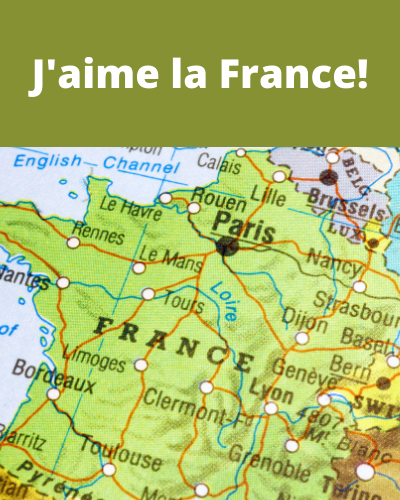French grammar lessons
French grammar lessons are absolutely essential for all those who wish to master speaking the language. French grammar consists of rules and patterns for the formation of sentences, verb tenses nouns and adjectives. This page is your gateway to studying French grammar in detail.

Many of my students have gotten off to a very good start by doing an online course. I have known Camille at Frenchtoday.com for many years and would highly recommend her course, À Moi Paris. Many people have also done very well with Rosetta Stone and Pimsleur. Here are my honest reviews of Rosetta Stone French and Pimsleur French.
Without knowledge of French grammar and simply learning vocabulary and phrases, you will forever be fumbling around trying in vain to make yourself understood. The benefit of mastering grammar is that you will know exactly which words go where.
On the grammar pages of Frenchlearner.com, we have tried to teach these rules and concepts in a fun way and provide lots of example sentences wherever possible.
Verb tenses and conjugations
One of your first tasks in learning French will be to familiarize yourself with the verbs. Your objective is to know how to conjugate verbs. This lesson covers basic French verb conjugations for the most commonly used verbs in French. This page offers an overview of French verb tenses you will need to know to speak fluently.
Regular verbs in the present tense
In order to build a solid foundation for speaking French, it is important to be able to conjugate regular verbs in the present tense. A ‘regular’ verb basically means that the verb endings follow a set pattern. The are three major groups of regular verbs in French. This page offers comprehensive coverage of regular verbs in the present tense.
Personal pronouns
One important task for all beginners is to learn the personal pronouns (also called subject pronouns). These are je (I), tu (you), il/elle/on (he, she one), nous (we), vous (you) and ils/elles (they). This lesson offers a complete overview of the personal pronouns.

Personal pronoun on
The French personal pronoun ‘on’ can cause a lot of confusion for beginners. This is because it has multiple uses. In addition to meaning ‘one’, this personal pronoun can also mean ‘people’ in general and also be use in the place of nouns (we). This post covers the personal pronoun on in detail and gives lots of example sentences.
Indirect and indirect objects
Another important early step in the process of learning French is learning the definite and indefinite articles. The definite article describe the English word ‘the’. The definite article in French changes depending on the gender and number of the noun it proceeds. The definite articles are le, la and les.
The indefinite article is the word for a or an. It to varies depending on the gender and number of the noun it proceeds. The French indefinite articles are un, une and des. This page covers the definite and indefinite articles in depth.
Gender of nouns
All French nouns have a gender masculine and feminine. Learning the gender of nouns is one of the hardest aspects to learning French. This is because there are no hard and fast rules for when a noun is masculine (proceeded by le) and when it is feminine (proceeded by la). This page offers an overview of spelling patterns for masculine and feminine nouns.
Passé Composé
The first pas tense that all students learn is called the passé composé. The tense is use for past actions that occured at a specific moment in time. Learning the passé composé involves learning which helping or auxiliary verb to use.
It is also necessary to learn the corresponding past participle for each verb. This page offers a comprehensive overview of the passé composé.

Imperfect (imparfait)
French has two commonly used tenses for the past. The second past tense is called the imparfait or the imperfect. The French use the imparfait to describe past actions that did not occur at a specific time. These are past actions that were in progress or ocurred regularly. This page offers a comprehensive lesson covering the French imperfect tense.
Plus-que-parfait
A second and more advanced tense to learn with the imparfait is called the plus-que-parfait, or pluperfect tense. It is used to describe two past events with one event preceding the other. For example, ‘Je n’ai pas mangé à 18h00 parce que j’avais mangé à 16h00. This page covers the plus-que-parfait in detial.
Future tense (futur proche and futur simple)
In French there are two main ways to express the future: The futur proche and the futur simple. The futur proche (near future tense) combines aller with an infinitive and expresses future events with a higher degree of certainty. The futur simple (or simply the future tense) is used to express future events with a slightly lower degree of certainty.
The futur simple is formed by putting specific endings on the end of the infinitive forms of verbs. This page offers a comprehensive lesson covering these two French future tenses. This page covers the past future (I will have) tense.
Conditional tense
The conditional tense is the ‘would’ tense. I would buy the car if I had enough money. Similar to the futur simple, the conditional is formed by adding specific endings to the end of the infinitive. These page covers both the present and past conditional in detail.
Subjunctive mood
The subjunctive mood is a difficult and more advanced tense that is absolutely necessary to learn. The requirements of the subjective are two personal pronouns separated by the word que (that). The French languages uses the subjunctive mood to express elements of wish, emotion and doubt. This page covers the subjunctive in detail.
Imperative
The imperative is the command tense. Examples in English are ‘Eat the pizza!’ or ‘Wash the car’. The imperative in French has three forms: 1) Tu (Parle français! speak French!), 2) Nous (parlons-français! let’s speak French!) and 3) Vous (Parlez français! Speak French!). This page covers the imperative in detail.

Negation
Negation describes how to make a negative sentence. The standard format for making a sentence negative in French is to wrap ne…pas around the verb. However, there are many other ways to make a sentence negative such as ne…jamais (never) and ne…rien (nothing, anything). This page covers rules and patterns of French negation in detail.
Reflexive verbs
Reflexiver verbs are used for actions that one does to him or herself. They are always preceded by a reflexive pronoun (me, te, se, nous, vous and se). For example, ‘Je me lave’ means I wash myself. We wash ourselves is ‘Nous nous lavons’. This page looks at reflexive verbs in detail.
Asking questions
There are several ways to ask questions in French. The standard way to ask a question is to put ‘est-ce que’ in front of a statement. This forms a yes-no question. The second most common way to ask a question is to invert the subject and the verb. This page offers a comprehensive look at French question words.
Stressed pronouns
Stress pronouns, also called tonic pronouns, are words which equate to him and her in English. In English, I don’t eat with he; I eat him. The same applies in French. You do not say ‘Je mange avec il’. Say, ‘Je mange avec lui. This page covers the stressed pronouns in detail.
Object Pronouns
Object pronouns are words used to replace nouns. Examples in English are it, them, he and she. The French language uses direct object pronouns for verbs not followed by the preposition à (to) and indirect object pronouns for verbs followed by à. This lesson covers French direct and indirect object pronouns in detail.

Relative pronouns
Relative pronouns are word that link together two phrases, such as that, which, and who. An example in English is ‘There’s the house that I’m going to buy’. The relative pronouns in French are qui, que, lequel, où and dont. This lesson covers the French relative pronouns in detail.
Gerund and en train de
There are two main ways to express ‘ing’ in French (e.g., I am speaking). The firs is to use what’s called the gerund, which is formed by combining en + present participle (en parlant, while speaking). The second way to express ‘ing’ is to use the en train de + infinitive structure (en train de manger, eating). This page covers the gerund and this page covers en train de.
Depuis and il y a
There are several ways to express ‘since’ in French and the rules can be a bit complicated. To express how long an activity has occurred, and it’s still occurring, depuis is used with the present tense.
If the activity is no longer occurring and stopped occurring in the past, then the passé composé is used. ‘Il y a’ can also be used to express since. This lesson covers depuis in detail and this lesson covers il y a.
Adverbs
Adverbs are words that modify verbs. For example, ‘I run quickly’. These words often end in -ent in French, such as ‘rapidement’ for quickly. This website looks at adverbs in three categories. The first group includes adverbs of manner. These include words such as ‘lentement’ (slowly) and ‘exactement’ (exactly).
The second group looks at adverbs of place. The group includes words such as ici (here) and over there (là-bas). The third group looks at adverbs of time. This includes words such as aujourd’hui (today) and demain (tomorrow).
Avoir besoin and avoir envie
Avoir besoin and avoir envie are verb expressions which mean to need and want. Both are followed by de plus either noun or infinitive. Examples are ‘j’ai besoin d’un café’ (I want a coffee) and ‘j’ai envie d’un café’ (I want a coffee).
When followed by an infinitive the meanings change: ‘J’ai besoin de boire un café’ translates to ‘I neee to drink a coffee. The following pages cover avoir besoin and avoir envie in detail.
Comparative and superlative
The comparative is used to make comparisons. Comparisons can be made with adjectives: ‘Je suis plus grand que toi’ (I’m taller than you), or ‘Tu cours plus vite que Marie’ (You run faster than Marie. Comparisons can also be made with nouns: ‘J’ai autant de voitures que toi’ (I have as many cars as you).
The superlative refers to adjective + -est in English such as the biggest or smallest. In French, ‘J’ai la plus grande voiture’ (I have the biggest car). This page covers the comparative and superlative in detail.

C’est vs il est
C’est and il est both mean ‘it is’. However, there are specific rules governing which one to use. The underlying rule the use of articles trigger the use of c’est. For example, to say ‘it’s a boy’, say ‘C’est un garçon’ and not ‘il est un garçon’.
Another way to look at il est vs c’est is: Il est + adjective and c’est + noun. However, the rules get much more complicated. This page covering c’est vs il est goes into the rules in great detail.
Demonstrative Adjectives
Demonstrative adjectives are words used to indicated this and that, such as this book and that book. Demonstrative adjectives must agree in gender and number with the noun they describe. Examples are ‘ce garçon’ (this boy) and cette fille (this girl). This lesson covers demonstrative adjectives in detail.
Interrogative Adjectives
Interrogative pronouns equate to the English word which as in ‘Which book do you want’? Interrogitive adjectives must agree with the gender and number of the noun they describe. For example, ‘Quel garçon’ (which girl)? and ‘Quelle fille?’ (which girl?). This page covers interrogative adjectives in detail.
Interrogative Pronoun
Interrogative pronoun equate to the English words ‘Which one?’ and ‘Which ones’? In French they must agree with noun they modify. For example, use ‘Lequel voulez-vous’? (which one do you want) to refer to a masculine noun such as a book (un livre).
Use ‘Laquelle voulez-vous?’ (Which one do you want?) to refer to something feminine such as a car (une voiture). This page covers interrogative pronouns in detail.
Demonstrative Pronouns
Demonstrative pronouns equate to the words ‘the one’ and ‘the ones’ in English. In French they must agree in gender and number to the nouns they modify.
For example, when talking about the book (le livre), say ‘Je voudrais celui là-bas’ to express ‘I’d like the one over there.’ When talking about the flower (la fleur), say ‘Je voudrais celle là-bas’ to express ‘I’d like the one over there. This page covers demonstrative pronouns in detail.

Direct vs. indirect speech
Direct and indirect speech deals with when to use quotation marks when quoting others. An example in English is: Tom said, “My friends are not coming” (direct) versus Tom said that his friends are not coming (indirect). In French, these sentences are: 1) Tom a dit: “Mes amis ne viennent pas”; and 2) Tom a dit que ses amis ne viennent pas. This page examines direct vs. indirect speech in detail.
Passé Récent
The French use the passé recent (resent past) tense to express ‘just’ as in ‘I just ate’. The format is to use venir (to come) conjugated in the present tense plus infinitive. For example, ‘Je viens de manger’. I just ate. this page covers the passé récent in detail.
Active voice vs passive voice
Examples of the active and passive voice in English are ‘The man buys the book’ and ‘The book is bought by the man’. The passive voice is used to put emphasis on the object (the book). In French these sentences are: 1) L’homme achète le livre and 2) Le livre est acheté par l’homme. This lesson examines the active vs. passive voice in detail.

En vs. dans
There are two ways to say ‘in’ in French: en and dans. Knowing when to use which can be confusing. Use en to express duration. For example, ‘Je finis le roman en deux jour’ (I finish the novel in two days). Use dans to express when future events will occur. For example, ‘Le film commence dans dix minutes’. This page examines en vs dans in detail.
Geographical prepositions
Geographical prepositions (e.g., in Rome, in France) can be quite difficult in French. The basic rule is: en + feminine country (en France), au + masculine country (au Canada) and à + city (à Paris). This page covers geographical prepositions in detail.
Prepositions à and de
The preposition à translates to at/to and the preposition de translates to from/of. The list of different ways to use these prepositions in French is endless. This page examines uses of à and this page examines uses of de. In addition, verbs can be followed by à and de.
For example, ‘Il continue à neiger’ (it continues snowing) and ‘Il arrête de chanter’ (he stops singing). This page covers uses of à and this page covers uses of de. This page examines verbs followed by à and this page examines verbs followed by de. This page gives a nice overview of most French prepositions.




